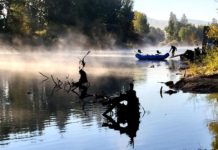Written by: Jon Clausen, Glacier Anglers, West Glacier, MT
All photos by Glacier Anglers
Winter fishing near Glacier National Park can be a surreal and rewarding experience, but it’s important to go prepared. The Flathead River and its tributaries run cold year-round, and during the winter months, snow and ice can make some areas inaccessible to all but the hardiest of anglers. Cold water mixed with cold air makes hypothermia a very real hazard here. Fishing can be tough at times–weather conditions play a major role in your success–but when it all lines up, having a native cutthroat on the line while surrounded by a silent blanket of snow can be one of the most memorable moments of the season. Here are five tips for fishing near Glacier National Park this winter:
1. Layer-Up and Avoid Felt-Soled Boots
All too often, winter fishing outings are cut short due to a lack of warm clothes: the more comfortable you are, the longer you can stay out, and the better your chances are for success. So put on your waders before leaving home, stick to synthetic or wool clothing, and stack up the layers, wearing a quality nylon shell or wading jacket over everything to keep you warm and dry. Avoid felt soles that can accumulate packed snow and weigh you down while you walk.

2. Be Aware of Your Surroundings
Know where you’re standing at all times. Ice shelves can form on riverbanks, and snow can hide the fact that you are actually suspended over deep water. Pick a fishing spot you’re familiar with, and keep a careful eye on your footing as you move along the bank. Be aware that many river access sites are not maintained during the winter, including snow removal in parking areas. If you plan to launch a boat, be sure to scout the section for ice dams first, and be prepared for rapidly-changing weather conditions. Floating the forks of the Flathead River during winter will test even the most experienced boater.
3. Bring Snowshoes or Skis
Accessing your favorite walk-wade spot may require snowshoes or even cross-country skis in the winter, which can be a unique and rewarding experience even if the fish aren’t cooperating. In this scenario, be prepared for winter backcountry travel even if it seems like you’re close to the truck, packing extra food, water and clothing. Keep tabs on your surroundings—avoid steep terrain and watch out for small avalanches. The deep snow will mean fewer anglers to compete with, but it also requires you to be self-sufficient and prepared to handle emergencies on your own.

4. Watch Out for Wildlife
While the bears are hunkered down for the winter, it’s still important to be aware of wildlife when fishing around Glacier National Park. Moose are at home in the river during the winter, even when the snow gets deep. They won’t be too welcoming if you happen to be in their area. Moose are unpredictable if they feel threatened, and mothers with calves are particularly protective and should be left alone at all costs. If your fishing spot is occupied by wildlife, find a different place to wet a line. These animals are expending a lot of energy moving through the snow and finding food. Pushing them from their wintering grounds could be extremely detrimental to their survival.
5. Tell Someone Where You’re Going
Be sure to let someone know where you will be, and when you will return. You may not want to give away your secret spot, but if you get stuck and don’t make it back, you want to be sure help is on the way. You might also consider taking a buddy with you, which will pay off either way: in case things go wrong, or in case you need a photographer for that first fish of 2023.
Jon Clausen is lead guide for Glacier Raft Company/ Glacier Anglers in West Glacier, MT
Credit: Source link































